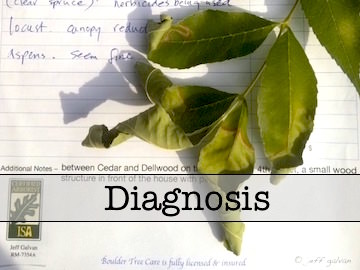
![]() A Tree Appears To Be In Decline
A Tree Appears To Be In Decline
What often draws attention and motivates individuals to take action is the appearance of symptoms that seem to be affecting the overall health of one or more trees on their property.
When this happens, our clients want to know one thing… Is there something we can do for trees that are showing signs of decline?
The answer depends on some very basic and important factors:
- What kind of tree is it?
- An accurate diagnosis – What is causing the problem?
- How long has the cause of decline been affecting the tree.
- Administering a treatment (when available) at a beneficial time.
- Observing and monitoring the results.
- Making necessary changes.
This may sound simple, but it’s not always easy. Understanding what the problem is and how to remedy it takes practice and experience.
Many variables affect the growth of a tree.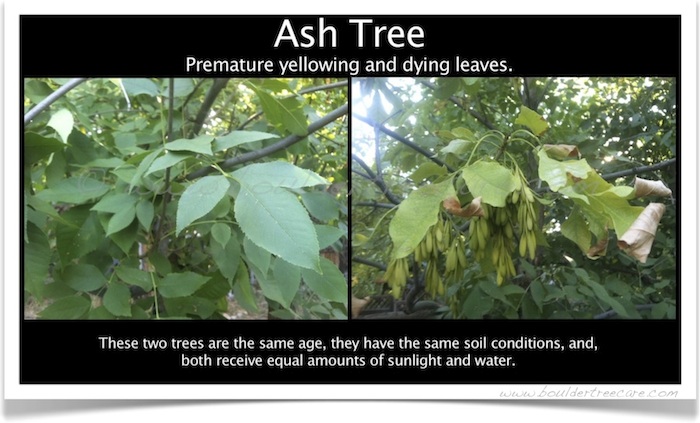
- Species – Location and Climate
- Nutrition – Balance of *NPK
- Water and Drainage
- Sunlight
- Competing Plants
- Soil Composition
It is common to hear that a tree was doing fine and then, suddenly… “It just started dying”.
Unless there is a serious trauma that has occurred, such as, a lightning strike or some sort of mechanical damage (construction) it may have gone unnoticed and perhaps it has been in slow decline for some time. Experience helps when it comes to seeing the first, early warning signs of a tree’s downward spiral.
 What Kind of Tree is it?
What Kind of Tree is it?
TREE IDENTIFICATION – Identifying a species.
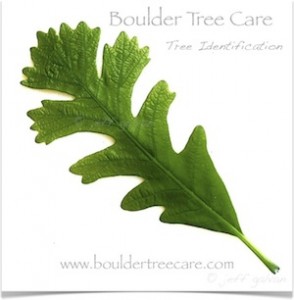 It is very useful to learn the botanical or scientific name of the tree receiving care.
It is very useful to learn the botanical or scientific name of the tree receiving care.
Proper tree identification can assist us when it comes to researching possible illnesses, diseases and problems associated with a specific type of tree. Since there is only one scientific name for each species, it aids us significantly in accurately communicating with others about the tree.
Please note: There is often useful information within the scientific name that is not present in the common tree name. Sometimes the common tree name may hold clues to finding out more about what type of tree it is.
The COMMON NAME of a tree can sometimes be HELPFUL OR CONFUSING when trying to find out specific information about a tree.
For example: Two of the common tree names for *Acer negundo are *boxelder and black ash. These common tree names might be misleading, since it is neither an elder nor an ash. On the other hand, it is also commonly known as an ash leaf maple which could be helpful when identifying the tree by it’s leaf because the leaves do look more like an ash leaf than a maple leaf.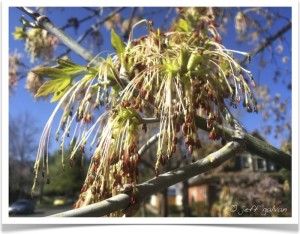
It’s scientific tree name is Acer negundo and therefore, with a quick search, we are able to identify the tree as a maple (Acer is a genus of trees we call maple). Now that we know the “universal” name we are able to communicate with others about a tree’s unique characteristics.
*also known as Ash Maple, Ash-leaf Maple, Black Ash, Cutleaf Maple, Cut-leaved Maple, Stinking Ash, Red River Maple, California Boxelder, Sugar Ash, Three-leaved Maple, and Western Boxelder.
 An Accurate Diagnosis – What is Causing the Problem?
An Accurate Diagnosis – What is Causing the Problem?
INSPECTION – Gathering information.
- Observe and monitor the symptoms to see if they are improving, staying the same or getting worst.
- Document the inspection (include photos) for future reference.
- Thoroughly examine the tree. Take notice of any obvious wounds, markings, insects, changes in coloration, scratches, holes, sawdust, damaged bark, dead wood, etc. at the base of trunk and on the branches, twigs, leaves, seeds or fruits.
- Check to see if there are any signs of mechanical damage. Damage caused by lawn mowers, weed trimmers and vehicles or construction machinery.
- Look to see if there is a noticeable amount of insects or fungus on the leaves or bark.
- Check to see if the soil is too moist or extremely dry.
- Look at other trees in the area (of the same species) and see how they are doing.
- Send soil or plant samples to a lab to be analyze.
Get more information and opinions from books, videos, online forums, a neighbor with the same kind of tree (maybe they dealt with a similar issue before) or you can always contact a local certified arborist to find out more about the health of your tree.
Note: Different environmental conditions can cause symptoms that look similar. Here are a few examples of different potential causes of premature yellowing leaves that are dying and falling off a tree:
- Watering too much, too often. Drainage (too slow).
- Not watering enough – sometimes looks more like over fertilization and dry, yellowing leaves appear burned. Drainage (too fast).
- Incorrect *NPK can cause premature yellowing, especially when a plant is in a vigorous growth cycle (in the springtime when it is producing all of it’s leaves or when a tree is having a bumper crop year).
- The wrong pH can block the uptake of available nutrients and may create the appearance of a nutrient deficiency.
- An imbalance of fungus, bacteria, invasive insects or other pathogens that feed off a tree’s vitality.
- Other trees and plants that are competing for sunlight, nutrients or are producing a phytotoxic (an organic, poisonous substance derived from plants) environment which is killing other plants to help establish themselves.
While any of these conditions are capable of causing similar symptoms, most require completely different treatments. An effective treatment for one of these causes may harm or kill a tree that is experiencing a decline due to a different cause.
If you treat a tree with fertilizer (because it appears to be nutrient deficient) and it actually has an undesirable soil pH (which is preventing it from being able to absorb nutrients) the tree could decline more rapidly – creating greater, long term damage. Likewise, if you only spray for insects, more often than not, you are only treating a symptom (which can occasionally be helpful in assisting a tree’s rebound) and not the cause of decline. Insects tend to feed on trees who’s immunity is already weakened.
Experience has demonstrated over and over again that if a tree is showing signs of serious stress and decline, unless you know the exact cause and cure, making sudden changes sometimes does more harm than good.
 Administering a Treatment
Administering a Treatment
REMEDY – Applying an effective a cure.
Once you have accurately diagnosed the problem, research to see if a commonly practiced and effective cure exist. If so, you have pinpointed the cause of the symptoms you are now ready to take action. Wait… Are you?
“The timing of treatment is as important as the diagnosis and prescribed remedy”.
Have doubt? Wait until you have sufficient information before beginning treatment.
 A Beneficial Time
A Beneficial Time
TIMING – When to take action.
A tree that has been under acute or chronic stress is in a fragile state. Too much, too quickly can put a tree into shock, even if the treatment is what the DR. ordered.
Q. It’s the middle of summer and you notice a tree is growing into the side of the house, over the neighbors yard and has begun to completely cover the only sunny spot on your property, where you like to grow your garden. t simply appears that the tree has outgrown the area it has lived for years. It desperately needs a canopy reduction. Is it the right time to call someone to prune the tree?
A. That depends. Leaves that are under the shade of the outer canopy have not been in direct sunlight all year and are often (on many types of trees) smaller and yellower than the leaves on the outer parts of the canopy. Those inner leaves are prone to getting sun damaged and dried out if they are suddenly exposed to full summer sunlight. Also, a tree needs to store the carbohydrates in it’s leaves before they all drop in the fall. Waiting until the tree no longer needs it’s leaves, the sunlight is less intense and before it grows new leaves next year might be a better overall plan of action for optimizing the health of the tree.
…
Q. The owner of a property who likes their lawn to be thick and green has noticed a tree that has been slowly turning yellow. Later it is diagnosed as having poor drainage and has, in effect, been getting too much water. Is it okay to stop watering until the tree recovers?
A. Trees that have been over watered for months can dry out too quickly. Their root systems may not have been growing very well for awhile and they need time to grow more robust roots. Reducing water takes time, giving the tree a chance to adapt.
…
Q. A tree that has had a bumper fruit crop this year now has many broken branches (because they’ve snapped under the weight of all the fruit it produced). Should I cut the branches?
A. While you may need to prune it dramatically, if possible, waiting until after fall may be more beneficial for the overall health of the tree. Sometimes it’s more beneficial for the tree to store the energy from it’s leaves in it’s root system before winter before removing the branches. To help the damage from getting any worst you may want to pick the fruit off early and support the broken branches.
…
Q. One summer you notice a tree that has not been doing well and it’s been growing very slowly. Turns out it’s not getting enough sunlight because it’s been living under the canopy of another tree. Then you find out the tree that is over crowding it is on the invasive species list and you don’t even want it on your property. Is it good to cut down the invasive species and make room for the tree that you desire to to better?
A. If the tree you want to keep is suddenly given full sunlight (say you cut down the competing tree in the summertime to make more light and room for a tree you desire to maintain) it may decline, or even die, from sun damage. Waiting until the winter months may give the tree a chance to acclimatize when it grows it’s leaves the following spring. Cutting down a good size tree in your yard changes the microclimate. For example: Soil that was shaded and often remain moist for days can dry much more quickly (maybe only a few hours, depending on the climate) now that it is exposed to more sunlight.
…
Watering a tree a whole bunch after it has suffered from getting little to no water all summer, spraying for pest that are eating leaves that are going to drop because autumn is just around the corner, cutting down a tree or whatever the case may be – there is a poor, doable and most beneficial time for most tree care practices.
 Observing and Monitoring the Results
Observing and Monitoring the Results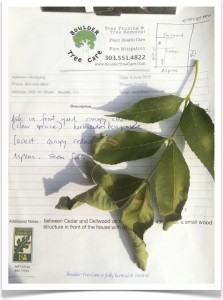
Review: INSPECTION – Gathering information
Observe the symptoms to see if they are improving, staying the same or getting worst.
When necessary, perform regular, detailed tree inspections. Take notice of any obvious wounds, marking, insects, changes in coloration, scratches, holes, sawdust, damaged bark, dead wood, etc. at the base of trunk and on the branches, twigs, leaves, seeds or fruits.
Document the changes from the initial inspection.
 Making Necessary Changes
Making Necessary Changes
This is where thorough, well documented inspections are really worth their weight in gold. Now, with changes observed and monitored we are now able to keep track of the progress and identify what has been helping and what has not. We will be able to reference the information gathered and it can be a valuable tool to help to assist us if any corrective action is necessary in the future.
 Preventable Causes of Stress to Trees Observed in the Field:
Preventable Causes of Stress to Trees Observed in the Field:
- Overwatering
- Soil compaction
- Mechanical damage caused by:
- lawn mowers and weed trimmers damaging tree trunks.
- support straps and synthetic twine (root balls) left on years after planting a young tree.
- lack of tree protection zones on construction sites.
- Poor drainage
- Too much (summer) or not enough (winter) sunlight
- Watering too close to the base of a tree. For established trees, it is usually better to water them at the outer circumference of a their canopy and not directly at the base of the tree. Watering too close to the trunk creates creates a dependance on water (similar to hydroponics). REMEMBER: Trees grow roots when they are searching for water and roots recede when they get too dry.
- Sprinkler heads that spray water on the tree’s trunk causing chronic stress. This is common when growing grass that needs large quantities of water to stay green and thick (grass that is not suited for this arid climate)
- Wrong pH for the species
- Incorrect fertilization.
- Not watering enough
- Species isn’t good for the location or climate.
- Improper pruning techniques.
- Use of herbicides
Before you use any kind of herbicides in your yard, you should definitely check out…
Changes in Trees
Changes in Trees – Test Results
*Additional Notes
*NPK – Nitrogen, Phosphorous, and Potassium
*Note: Sometimes, there’s plenty of nutrition in the soil and the food is ‘locked up’. The tree cannot uptake the nutrients in the soil because the pH is not good for the type of tree. Therefore, adding fertilizer will only harm the tree.
Boulder Tree Care writes articles about daily experiences while providing tree care in Boulder, Colorado.